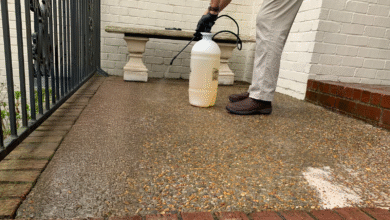Design Trends for Modern Patios: Creating Functional Outdoor Living Spaces

Key Takeaways
- Modern patio design seamlessly blends style, function, and sustainability to create functional and aesthetically pleasing outdoor living spaces.
- Popular trends include eco-friendly materials, multi-use layouts, and integration of natural elements.
- Innovative technology and weather-resistant features improve comfort and usability year-round.
- Creative lighting, low-maintenance landscaping, and versatile furniture extend patio enjoyment into the evening and across seasons.
Modern Patio Essentials
Outdoor living spaces have evolved dramatically over the last decade, now becoming one of the most desirable aspects of a home for both relaxation and functionality. Today’s patios are not simply functional—they’re designed as seamless blends between indoor and outdoor living. As more people invest time and effort into their homes, these once-forgotten corners have transformed into stylish retreats where family and friends gather to connect, unwind, and celebrate special moments.
As people rethink how their outdoor environments support daily living, it’s more common than ever to see detailed wish lists that incorporate technology, comfort, style, and sustainability. For those searching for solutions like patio builders near me in Chantilly, VA or in other locations, expectations now include not just beautiful results but also patios that are purpose-built for entertaining, cooking, working, and relaxing. Patios serve as an extension of one’s personality, available year-round, making them a key feature in contemporary home design.
Eco-Friendly Materials on the Rise
Sustainability is more than a buzzword—it’s a guiding principle for modern patio design. Homeowners are willing to go the extra mile, choosing innovative pavers made from recycled plastics, composite decking derived from reclaimed wood, and responsibly sourced hardwood certified by organizations like the Forest Stewardship Council. These materials reduce the demand for virgin resources and help divert waste from landfills, lessening the environmental impact of exterior upgrades.
One of the major appeals of these eco-friendly options is their long-term durability. Unlike traditional wood, which requires constant staining and upkeep, composites often need only occasional cleaning. Likewise, recycled pavers resist cracking and fading, keeping patios looking vibrant through brutal summers and icy winters. Choosing locally sourced materials further reduces transportation emissions. Savvy homeowners can increase the eco-value of their outdoor sanctuaries by selecting permeable surfaces that encourage natural water flow, combating runoff and erosion. These sustainable design choices support both a healthy planet and a beautiful, low-maintenance space.
Layout Flexibility for Multi-Use Spaces
Today’s patios need to adapt—sometimes at a moment’s notice—to serve a wide variety of functions. Space constraints, lifestyle changes, or just a spur-of-the-moment urge to host a backyard barbecue all mean layouts should be as flexible as possible. Modern design principles focus on creating multiple “zones” within the patio, using changes in elevation, built-in planters, screens, or even different flooring materials to define dining, lounging, and play areas subtly.
Consider the transformation of a small backyard: what was once an underutilized patch of grass now shifts fluidly between a breakfast spot, a child’s play area, and an inviting space for evening gatherings. Features like movable sectional sofas, collapsible tables, or benches with integrated storage make it easy to switch up the setup in seconds. This kind of flexibility is ideal for growing families, home workers, or anyone who enjoys entertaining. When each corner serves more than one purpose, no square inch is wasted—and the patio becomes a true asset to the home.
Nature-Inspired Integration
There’s a growing appetite for patios that feel less like add-ons and more like organic extensions of their surroundings. This is driving a rise in nature-inspired design strategies, from lush vertical gardens and layered beds of native plants to edging rivers of smooth stones or incorporating water features and bird-friendly plantings. Integrating greenery directly into the architecture—think living walls, trellises, or built-in planter benches—blurs boundaries and enriches the sensory experience.
Studies suggest that even a small dose of nature can help boost mood, relieve stress, and support overall well-being. The tenets of biophilic design encourage homeowners to let local landscapes guide their choices, cultivating both resilience and beauty. Choosing native plants creates a maintenance-light, drought-tolerant ecosystem that supports birds, pollinators, and other wildlife. With thoughtful integration, a patio becomes an immersive escape, offering relaxation while supporting local biodiversity.
Technology Enhancements in Patio Design
The latest patio trends show a keen interest in blending convenience and entertainment. Homeowners are budgeting for features such as voice-activated lighting, weather-resistant speakers that deliver high-quality sound without visual clutter, and built-in USB charging ports. Hidden wiring, low-profile speakers, and remotely managed lighting systems are making it easy to enjoy music, change the ambiance, or adjust to changing weather—all without leaving your seat.
Innovative technology adds a layer of luxury and safety, from motion sensors that illuminate paths to programmable lights that adapt based on sunset times. Feedback from many users indicates the value of all-weather control systems; even simple upgrades, such as solar-powered accent lights or Wi-Fi-enabled irrigation systems, deliver a significant impact. Selecting devices designed for outdoor use and tucking control hubs out of sight helps maintain a polished, clutter-free look while providing high-end convenience features.
Creative Lighting and Low-Maintenance Landscaping
The proper lighting breathes life into a patio, completely altering how the space feels from day to night. A creative mix of string lighting, solar-powered lamps, pathway markers, and LED uplighting allows for dramatic effects without overwhelming the senses—or the electric bill. Layered lighting plans create pathways for safe movement after dark, while zones near dining or lounge areas can be adjusted for a cozy, welcoming glow.
Landscaping that’s beautiful but tough makes outdoor living easier. Drought-resistant grasses and succulents, as well as groundcovers that replace traditional lawns and low-maintenance shrubs, all reduce time-consuming yard work. Elements like mulched beds, gravel, and native wildflowers naturally control weeds and pests while adding visual texture and interest. These strategies ensure that even busy homeowners can maintain an attractive, inviting patio without constant effort.
Designing for Year-Round Outdoor Enjoyment
The appeal of a patio that functions throughout all four seasons is stronger than ever. Solutions like pergolas with retractable shades or louvered roofs protect against harsh sun or sudden rain, while permanent or portable fire pits become magnets for gatherings on chilly nights. Add in patio heaters, and suddenly, outdoor dining or game nights are just as comfortable in November as in June.
Weatherproof furnishings—think rust-resistant metals, quick-drying cushions, and all-weather woven rugs—offer both durability and comfort. Heavy-duty textiles in bold patterns or natural hues withstand fading and mildew, ensuring that even when the weather turns, the patio remains attractive and usable. Layering blankets, throws, and plush pillows creates an indoors-out vibe, encouraging household members to unwind outside, no matter what the forecast brings.
Finding Inspiration and Keeping Current
Inspiration for patio design is everywhere, and keeping up with the latest outdoor living trends is as easy as scrolling through a feed or visiting a design showcase. Resources such as top design magazines, home improvement TV segments, and online galleries showcase innovative uses of materials, color schemes, and spatial layouts. These sources help homeowners spark new ideas, improve existing spaces, and keep their patios fresh and modern for years to come.
Each successful patio transformation is a blend of current trends and unique personal touches. The key is to use the wealth of available inspiration as a springboard, layering in preferences and practical needs. Whether you prefer a sleek and minimalist or a wild and bohemian style, a thoughtfully designed patio has the power to enhance your daily routine while boosting your overall property value. The opportunities for creativity, relaxation, and connection are limited only by imagination—and by the outdoor space right outside your door.




